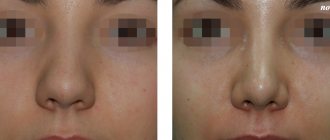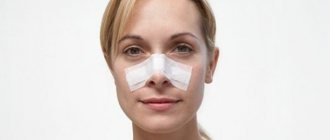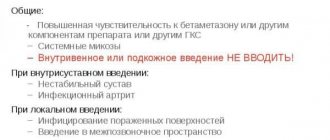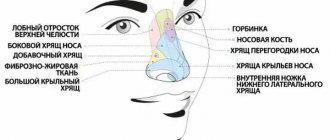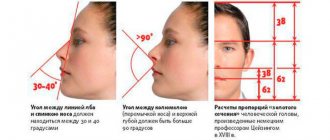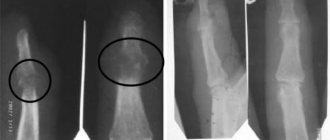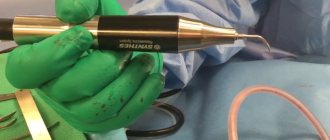Mechanism of occurrence
Swelling, oddly enough, after rhinoplasty is necessary for the speedy healing of surgical incisions. The accumulation of a large amount of fluid in the subcutaneous tissue promotes the regeneration process and accelerated cell division. Therefore, swelling after rhinoplasty is a normal reaction of the body and it lasts as long as necessary for tissue healing.
Sizes vary depending on the extent of surgery. If bone structures were involved, then, of course, the area of edema becomes larger. Even after non-surgical interventions, the nose and surrounding tissues swell. Although the doctor just injects a gel with a needle, which pushes the structures apart.
The effectiveness of microcurrents for the face after rhinoplasty
A physiotherapeutic course after surgery allows you to:
- accelerate tissue restoration and healing;
- improves the skin regeneration process;
- makes the recovery period more comfortable, reducing negative consequences;
- reduces congestion;
- reduces swelling in the intervention area;
- helps restore the sense of smell;
- restores sensitivity of the tip of the nose;
- normalizes respiratory function;
- Helps quickly resolve scars after surgery.
After just a few procedures, microcurrent therapy gives visible results. Swelling goes away after the first use. The hemodynamics of the postoperative area are influenced by several mechanisms. Physiotherapy allows you to speed up tissue and cellular metabolism and improve tissue condition.
Basic actions of microcurrents:
- Stimulation of the recovery process;
- Improving blood microcirculation at the level of small capillaries and arteries;
- Lymphatic drainage effect, accelerates the removal of excess fluid from cells, connective tissue and subcutaneous tissue;
- Improved oxygenation due to increased circulation;
- Normalization of tissue metabolism;
- Strengthening the walls of blood vessels, reducing the severity of esudative phenomena.
How long does swelling last?
The swelling goes away completely, in most patients, within a year. During this time, the patient goes through several stages of rehabilitation. It is worth remembering that swelling goes away for everyone at different rates; it depends on the characteristics of the body, as well as on the correctness of the rehabilitation.
First stage
The duration of this period is one week. The most difficult time psychologically and physically. Swelling begins to form when the surgeon performs the operation, and after that it only increases. To avoid deformation of the operated tissues, a fixing splint or bandage is applied to the nose, so excess fluid accumulates in the area of the eyelids and cheeks.
The volumes of excess fluid can be as large as desired, and in some patients the eyes are invisible.
Already during this period you need to follow the rules:
- sleep in a half-sitting position; a large pillow placed under your back will help with this;
- do not tilt your head or body;
- Do not under any circumstances visit a bathhouse or sauna, or stay in hot rooms;
- apply cold compresses as recommended by your doctor;
- do not wet the splint while washing;
- do not touch your face, do not use care products.
When the first week of rehabilitation passes, the patient is forced to remain in isolation. Doctors should prepare for this in advance.
Second phase
This period lasts two weeks. During this time, with good regenerative abilities of the body, the swelling quickly subsides and becomes noticeable only to the patient.
For accelerated rehabilitation it is necessary:
- do not sleep on your stomach or side;
- choose delicate facial care, that is, do not use aggressive cleansers, and do not press too hard on the skin when applying makeup;
- avoid heat exposure;
- Do not play sports, do not bend over.
At this time, doctors prescribe lymphatic drainage and absorbable gels, but you should not expect a miracle effect from them - the swelling will subside faster, but will not go away forever.
Third stage
This is the period from the second to third month after surgery. In the previous stages, up to 50% of the swelling goes away, which now remains in the form of seals in the tip of the nose and its back. Now it depends on the patient how quickly the remaining part comes off.
To reduce swelling, you must exclude:
- smoking;
- drinking alcohol;
- inactivity;
- mechanical effects on the nose (wearing glasses, constant scratching);
- tilts of the body and head;
- sleeping position on your side or stomach.
As long as the period from the first to the third stage lasts, you cannot expose your face to thermal influences for that long.
Fourth stage
This is the period when inflammation is completely eliminated. Continues from the fourth to the twelfth month of rehabilitation. At this stage, the swelling is no longer noticeable to others; only the patient herself feels the seal in those parts of the nose that were most involved.
For the remaining six months of rehabilitation, you can wait until everything resolves on its own or undergo physical procedures as directed by a doctor. Among them are ultrasound and phonophoresis, which improve tissue microcirculation.
How long does swelling last after nasal tip rhinoplasty?
There is a noticeable difference between a full rhinoplasty and a tip rhinoplasty. In the first case, bone tissue is necessarily affected, in the second - only cartilage and skin. Due to less trauma, rehabilitation is faster, and swelling may subside by 6 months after surgery. As a rule, patients who have undergone tip rhinoplasty do not notice severe swelling on the face - rather, they are concerned about its hardness and enlargement.
If the plastic surgeon worked with outdated technology, in the early stages of rehabilitation, excessive upturning of the tip of the nose is possible, which then gradually drops. If rhinoplasty was carried out according to a modern scheme (structural rhinoplasty), a rigid supporting structure made of cartilage will not allow the tissues to move and deform, so the tip will remain in the same place, with an ideal nasolabial angle.
Structural rhinoplasty completely eliminates such delayed defects as upturning of the tip of the nose like a “piglet” or its drooping like an “eagle’s beak.”
Drugs
Traumeel S (ointment or tablets)
It is used for rapid resorption of hematomas and elimination of edema. Prescribed by a doctor and used twice a day. It is used as long as the second and third stages last.
The gel and tablets contain homeopathic components of chamomile, calendula, echinacea, mountain arnica, comfrey, St. John's wort and some other herbs.
Bromelain
The drug in tablets is prescribed for preventive purposes to prevent severe swelling after surgery. The active component of the product is a pineapple extract containing an anti-inflammatory enzyme.
Taking pills must be agreed with your doctor.
Dimexide
The solution is used to treat swollen areas. The effect of using the drug: pain relief, swelling relief, disinfection.
Dimexide has serious contraindications: kidney and liver diseases, angina pectoris, myocardial infarction, stroke.
Plaster after surgery
Wearing Features
The postoperative period after nose correction can last up to three months; it is during this period that complications can develop. In some cases, wearing a cast is part of the rehabilitation; many experienced surgeons resort to this procedure.
After rhinoplasty, swelling of the face can last a long time, since the procedure affects the blood vessels in the nose, and the application of a cast controls the swelling. Of course, after it is removed, the swelling will still persist, and the shape of the nose will not correspond to the expected result. That is why the final result is assessed after 7-8 months, when the bones and cartilage tissue of the nose are completely restored.
Another important function of gypsum is protection against mechanical damage. After rhinoplasty, the tissues of the nose are very soft and any bruise can cause their deformation. The plaster will protect the new form from accidental damage. It is forbidden to remove it yourself, squeeze it, or get it wet - any impact on it can lead to undesirable results.
Plaster after rhinoplasty (photo)
After how many days is it removed?
Wearing a cast after rhinoplasty causes a lot of inconvenience, so a natural question arises: when can it be removed? It prevents you not only from going outside and getting to work, but also from breathing fully. Tampons placed in the nose make it difficult to breathe through the nose, so you have to breathe only through your mouth. Despite the inconvenience, they eliminate nosebleeds and protect the septum from possible damage.
Tampons can be removed the very next day after surgery, maximum on the third day. The cast lasts a little longer - it is removed 7-10 days after the procedure.
The key to successful rhinoplasty is not only the experience of the surgeon, but also a properly completed rehabilitation period.
Everything you need to know about plaster after rhinoplasty is collected in this video:
Traditional methods
From the second and third stages, you can turn to traditional medicine recipes.
A decoction of mountain arnica can be used as tea or compresses. In any case, two teaspoons are poured into a glass of boiling water and infused.
Take 200 g of pineapple pulp on an empty stomach three times a day. The effect is similar to Bromelain: the active substances contained in pineapple provide an anti-inflammatory effect.
Aloe leaves are applied to swollen areas for several minutes.
Tea with ginger root is recommended as an anti-inflammatory and decongestant.
How to speed up the recovery process after rhinoplasty?
It is indeed possible to speed up the recovery process. The main thing here is to strictly follow all the doctor’s recommendations. All restrictions imposed during the recovery period are temporary. Just a few weeks of proper nutrition, giving up cigarettes and alcohol, following simple rules, and you will get the nose you dreamed of.
But folk remedies and miracle ointments are unlikely to help you. Over the years of practice, I have come across only one effective drug - Skargard. Everything else will calm your nerves, but will not give results.
Sign up for a free consultation now.
Physiotherapy
Microcurrents
The procedure improves metabolism at the cellular level. Microcurrents imitate natural biological impulses passing through healthy tissues of the body. The main advantage is that the device has a targeted effect on specific areas.
Ultraphonophoresis
During this procedure, the skin becomes more receptive to nutrients, blood circulation and exchange within cells are accelerated. The effects are provided by ultrasound. The procedure not only reduces swelling, but rather promotes tissue regeneration.
Pros of microcurrents
Like all physiotherapeutic procedures, this course can only be prescribed by your personal doctor. It also determines the number of procedures that need to be performed. Most often it ranges between 6 and 10 sessions. Many patients are concerned about the question of what day to do microcurrents after rhinoplasty. This purpose is purely individual, and depends on the complexity of the operation, the progress of rehabilitation, and the individual characteristics of the body. The duration and timing of therapy can only be determined by a plastic surgeon.
The main advantage of this restoration technique is its simplicity. The essence of therapy is exposure to low-intensity current pulses. The painlessness and effectiveness of microcurrents is due to the charge characteristics, which are similar in parameters to the electrical activity of cell membranes. The therapy feels quite pleasant, similar to a light massage. Before the procedure, the doctor must apply a special gel to the affected area, which improves current conductivity. After which the direct impact begins, using special gloves or small electrodes to which a current is applied.
The main advantages of microcurrent therapy:
- safety;
- affordability;
- no pain.
Despite the fact that there are other procedures for recovery after rhinoplasty, current therapy occupies a leading position among patients due to its rapid positive effect.
